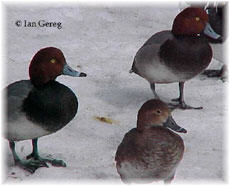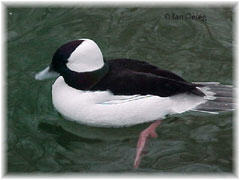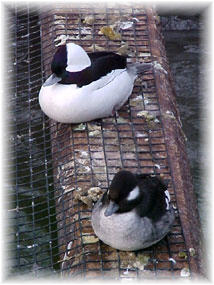 |
||
| Redhead Drake | Redhead Group |
Red
Crested Pochard:
European and Asian species, breeding mainly in Russia. Bright
red bushy crest is obvious in males. Although very good at diving for
food, they may dabble or up-end for food.
| Red Crested Pochard Group |
Rosybill
Pochard:
Southern South American species with obvious bright pink knob on the
forehead of males, which swells during the breeding season and brightens in
color. Has the peculiar habit of jumping into a dive instead of sinking
under like most divers.
| Rosybill Pochard Drake |
Canvasback:
A strictly North American species, which is the largest of the
pochards with a long tapering bill and sloping forehead. The head has a
wedge-shaped profile. One of the fastest flying ducks, they utilize a
v-shaped formation while migrating like geese to increase efficiency.
| Canvasback Hen |
Redhead:
A North American pochard, smaller than the canvasback and closely
related to the European pochard. The male redhead can be differentiated by
its yellow iris, as compared to the canvasback and European pochard, which have
a red iris.
 |
||
| Redhead Drake | Redhead Group |
Ferruginous
White-Eye:
A small Eurasian species with a deep chestnut coloration. Male
has a bright white iris, while the female resembles a tufted duck female with a
brown iris.
Ring-Necked
Duck:
A small North American diving duck. The name is confusing, as
the ring on the base of the neck is only visible while in hand. The more
often used name is the Ringbill, because of the white ring on the bill of both
sexes.
| Ring-Necked Drakes |
Tufted
Duck:
A widespread diver from Europe and Asia. The males are easy to
identify by the long crest on the back of the head. Females do not have as
long a crest. They obtain food entirely by diving.
| Tufted Duck Drake |
Lesser
Scaup:
A North American species, primarily on the West Coast. The most
numerous diving duck in North America. Stays inland except for bad
winters, which it spends at sea. Far more numerous than the greater scaup
in the United States. Barring on the sides distinguishes it from the
Greater Scaup.
Greater
Scaup:
Ranges across Pacific North America and all of northern Europe and
Asia. Larger than the lesser scaup with no barring on the flanks.
Not possible to distinguish the two from long distances. It is more adept
at sea life than the lesser scaup.
| Greater Scaup Hen |
Common
Goldeneye:
Ranges all across the northern United States, Europe, and Asia.
Drakes plumage is a distinct black and white pattern. Loud whistling
produced by the wings while flying is characteristic of this species.
Green sheen to head with circular spot near bill identifies it compared to the
male Barrow's Goldeneye; females are similar. Nests in tree holes and duck
boxes.
| Common Goldeneye Duckling |
Barrow's
Goldeneye:
Breeds across the entire northern North America. Distinguished
from the common goldeneye by purple sheen to head, crescent shape spot on face,
and the line of white spots on the wing. Also makes a whistle with the
wings while in flight. A strong flier but needs to run for quite some time
along the water to become airborne on windless days. Also nests in dead or
dying trees or duck boxes.
| Barrow's Goldeneye Drake | Barrow's Goldeneye Hen | Barrow's Goldeneye Duckling |
Bufflehead:
Ranges across northern North America. Much smaller than the
other two species of Goldeneyes. Short neck with small bill and a head
puffed out to almost twice its normal size (hence the original name of Buffalo-
Head). No whistling wings like the other goldeneyes. Very active and
restless. Nests in tree holes and duck boxes.
 |
 |
|
| Bufflehead Drake | Bufflehead Pair |
![]()
Comments? Questions? Email [email protected].
Copyright � 2003
Last modified: May 23, 2003